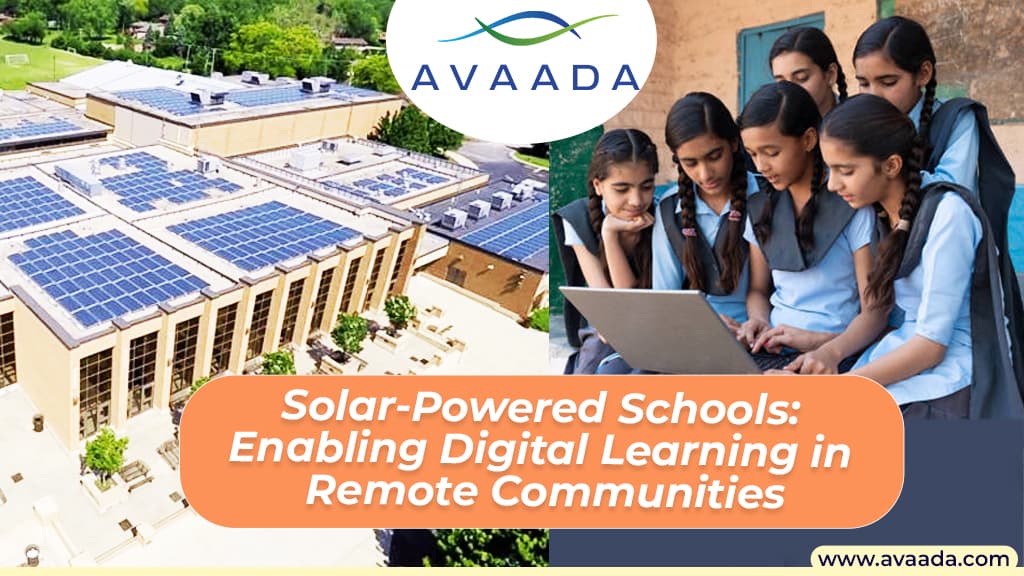In this increasingly interlinked world, digital learning forms the backbone of modern education. Yet, in several remote communities, it remains a challenge to achieve electricity with high reliability to adopt technology-driven teaching methods. Enter solar-powered schools—an innovative solution bridging the gap between remote education and digital transformation. By harnessing the power of the sun, these schools are empowering students and educators in areas where traditional power infrastructure is lacking.
Need for Solar-Powered Schools
Quality education is a human right but millions of children living in remote regions face several barriers to their learning opportunities. Of these, the main barrier is unreliable electricity or no electricity at all. In areas without a regular power supply, schools cannot make important tools like computers and internet connections or multimedia sources that makes learning lively and vibrant.
Declining costs of panels and emerging battery storage technology will mean even remote communities can derive some utility from renewable sources. More than providing the much-needed reliable energy for a solar-powered school, this benefits the global agenda on sustainability and carbon footprint reduction.
Explore our blog on Understanding the parameters in a Solar Panel Data Sheet
How Solar Power Supports Digital Learning
The solar-powered schools have fitted solar panels that produce electricity during the day and save extra energy in the batteries to be used when it is cloudy or at night. This energy is used to power the important devices and infrastructure that include the following:
- Digital Classrooms: The solar energy powers computers, projectors, and interactive whiteboards, which will enable the teachers to adopt digital tools in their teachings.
- Internet connectivity: With a stable power supply, the internet is accessible at all times and has a vast array of online resources, virtual classrooms, and educational platforms.
- E-Learning devices: Tablets, laptops, and other electronic devices can be charged and used without interruption, and students can have hands-on experience in using modern technology.
- Lighting and Cooling Systems: Solar power ensures a well-lit and warm learning environment, which promotes extended study hours and classroom conditions.
Revolutionizing Education for Remote Communities
The solar-powered school impact is significant and extends beyond the walls of the classroom to leave a lasting social and economic impact on remote communities. These include:
- Better Results in Education: With the provision of digital tools, students are able to work on interactive and multimedia-rich content to enhance understanding and retention. Teachers also receive online training programs that ensure quality education.
- Enrollment and Attendance Improvement: Reliable electricity and improved facilities make schools more attractive to students and parents. The enrollment rates and attendance improve as education becomes easier and engaging in solar-powered schools.
- Empowerment of the Community: The solar power systems can benefit the whole community by providing electricity for events, charging stations, and even water pumping systems. This fosters a sense of ownership and pride among community members.
- Gender Equality: More girls face obstacles to education than boys. Better lights and infrastructure enable girls to attend school safely and read & study after sunset.
Case Studies: Solar Success Stories
Many programs around the world show how schools can change lives with solar power:
- Sub-Saharan Africa: Thousands of students in Kenya and Uganda are being prepared for a technology-driven future through digital learning tools offered by solar-powered schools.
- India: In remote villages of Rajasthan and Odisha, solar energy is used to bring internet connectivity and e-learning programs to under-served schools.
- Latin America: Solar classrooms will be implemented in the rural schools of Colombia and Peru, empowering indigenous communities to create their cultural heritage through digital storytelling.
Learn about Understanding Renewable Energy Certificates (RECs) in India.
Overcoming Challenges and Ensuring Sustainability
Implementing solar-powered schools is not without challenges. Significant barriers include costs of setting up initially, the cost of maintaining the solar panel and batteries, and staff training on how to work with digital equipment. In the context of partnerships between government and non-profits organizations with private funding sources, technical aid, and training programs to support sustainability can be generated.
Future of Education
As technology improves in the future of education, solar-powered schools become an important milestone in becoming more inclusive and sustainable. They will be addressing the energy requirements of far-flung communities so that remote students would have a chance to avail themselves of digital learning facilities that previously could not access due to distance.
With collective efforts by global stakeholders, solar-powered schools can be a model for equitable and sustainable education systems around the world. They are a promise of a brighter future where every child, regardless of location, has the tools to learn, grow, and thrive.









